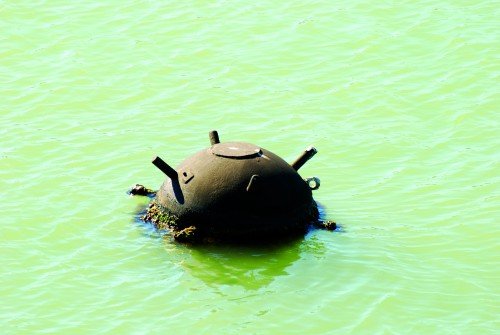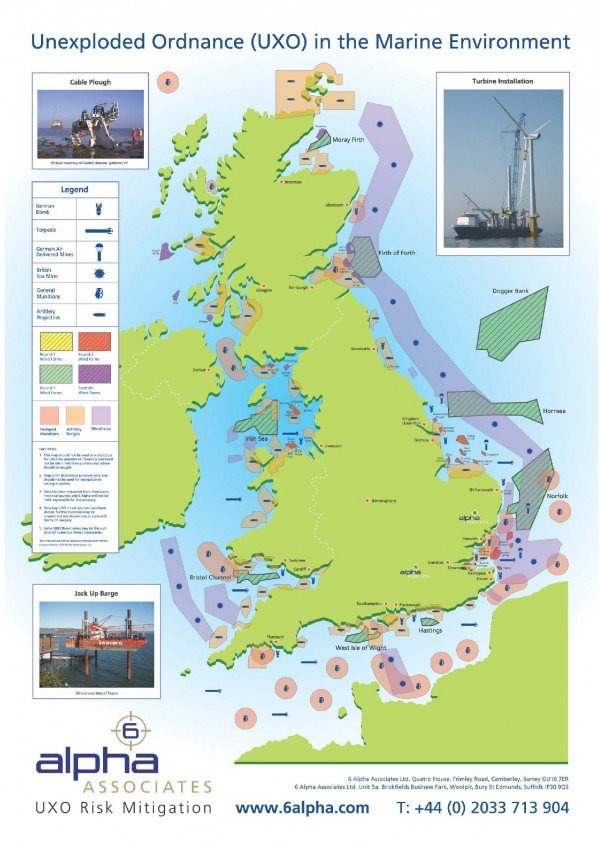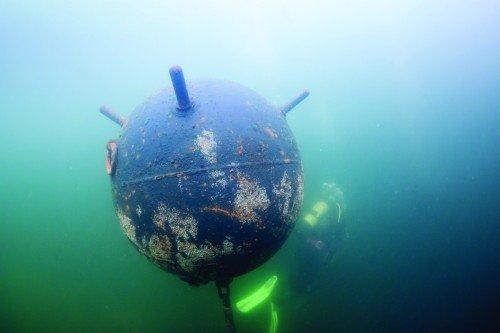As marine renewable energy begins to proliferate in European waters, developers and contractors must quickly come to terms with the hidden threat posed by unexploded ordnance (UXO) to enable the safe and timely delivery of projects. Simon Cooke explores how this risk can be diffused.

Over the past decade, Europe has witnessed a boom in marine construction. Traditional oil and gas drilling continues at a steady pace and, with renewable energy developers also making the move into the marine environment, a host of intrusive and aggressive seabed activities have been sparked in the waters of the North Sea, ranging from geotechnical investigations to cable laying and foundation installation.
Offshore wind projects in particular are now becoming a common sight off the coasts of the UK, Germany, France and Denmark as these countries strive to meet 2020 renewables targets. Statistics from the European Wind Energy Association (EWEA) show that 282 wind turbines were erected in the first half of 2014, with 233 foundations installed on 13 individual wind farms throughout Europe.
Necessitating a significant amount of supporting infrastructure, including foundations for the wind turbine generator (WTG) and substation, platforms and the extensive cable network needed in the array and to bring power back onshore, offshore wind projects now have a substantial, growing footprint on the European seabed.
However, while Europe continues to set the pace for marine energy development globally, this rapid expansion is not without its risks. As offshore wind sites move further offshore and increase in size and sophistication, developers in the North Sea are increasingly coming face to face with a unique obstacle to the safe and timely completion of their projects in the form of thousands of tonnes of unexploded ordnance (UXO).
This is a man-made legacy left behind by a century of military conflicts and related activity. Mine laying, naval battles and bombing during the two world wars, together with the dumping of expired munitions and ongoing military training procedures have left a deadly cocktail of explosive weaponry on, or buried just under the surface of, the seabed across Europe.
Unaccounted-for mines
 The true scale of the UXO threat to marine construction projects is extremely significant, and yet difficult to quantify. Of the sea mines deployed by Allied and Axis forces during the two world wars, as few as 70 per cent were recovered, leaving the remaining 30 per cent unaccounted for. Likewise, during the Second World War, many torpedoes and bombs would commonly miss their intended targets during naval combat and air raids. Given that 10 per cent of bombs dropped during this conflict failed to detonate as intended, they are likely to now sit, unexploded, on the ocean floor.
The true scale of the UXO threat to marine construction projects is extremely significant, and yet difficult to quantify. Of the sea mines deployed by Allied and Axis forces during the two world wars, as few as 70 per cent were recovered, leaving the remaining 30 per cent unaccounted for. Likewise, during the Second World War, many torpedoes and bombs would commonly miss their intended targets during naval combat and air raids. Given that 10 per cent of bombs dropped during this conflict failed to detonate as intended, they are likely to now sit, unexploded, on the ocean floor.
In addition, extensive and organised dumping of expired chemical and conventional explosive munitions took place across Europe during a 60-year period following the end of the war, continuing well into the 1980s. Even at these designated marine munitions dumps, records cannot be fully relied upon, given evidence of lax disposal procedures that took place at the time, which often resulted in munitions being dumped along the route to and from the designated dumping zones.
It is therefore no surprise that the rate of UXO discovery to date in European waters confirms that a tangible, calculable threat is posed to worker safety on marine construction sites. A First World War sea mine is encountered around once a decade, while Second World War mines are found once a year and bombs of varying size and origin are regularly discovered.
High impact risks
Expired weapons of this nature are highly dangerous, but not inherently volatile. This means that, in the absence of external energy, they are very unlikely to initiate of their own accord. Regular marine traffic is, thereby, as a rule, not at risk. However, any high impact disturbance to the seabed – of the sort generated by investigative drilling, piling or the actions associated with cable installation – is capable of triggering an extremely destructive explosive event.
In short, the range of subsurface activity associated with offshore wind and marine energy development greatly elevates the risk of an inadvertent detonation. Should a cable plough, drill or WTG foundation come into contact with and initiate UXO (on the surface or shallow-buried), depending on a range of factors, including the size of the high explosive charge and the depth of water, the resultant blast is likely to be capable of affecting vessels hundreds of metres from the seat of the explosion.
Such an event would certainly cause extensive damage to vessels nearby as well as to project-critical infrastructure. UXO entangled in grapnel or cabling installation equipment and inadvertently brought back to a vessel is clearly capable of causing even greater damage and it poses a substantial hazard to personnel and equipment.
The risk presented by UXO to marine construction is therefore twofold; at the very least an uncontrolled detonation will cause significant project damage, bringing about construction delay and associated costs. In the very worst-case scenario, it may fatally injure workers in the near vicinity.
As such, there is a clear imperative for developers to mitigate and reduce these inherent project safety and financial risks, in order to safeguard the reputation of the funders, stakeholders and the project as a whole, as well as the ongoing reputation of the renewable energy industry for safe installation in the marine environment.
Unknown threat
It’s a persistent concern for UXO risk management specialists that firms working throughout the offshore wind supply chain are not fully aware that UXO may be present on their site and has the potential to severely hinder project delivery. Such risks fall squarely into the remit of developers and their principal contractors to responsibly manage the safety of all sub-contractors and installers working on-site.
Health and safety practitioners across the UK construction industry will be well acquainted with the wider implications of the Construction Design & Management Regulations and the Corporate Manslaughter and Homicide Act, both of 2007. Combined, this legislation places significant legal responsibility for the management of construction risks at the highest level, meaning that, should negligence be proven in the instance of injury to personnel, or loss of life, senior managers and directors are liable for unlimited fines and even imprisonment.
 Quite aside from this legal responsibility, developers would also do well to learn from several high-profile instances where mismanagement of UXO risk on-site has impacted severely on project schedules, generating significant and unexpected costs.
Quite aside from this legal responsibility, developers would also do well to learn from several high-profile instances where mismanagement of UXO risk on-site has impacted severely on project schedules, generating significant and unexpected costs.
One such instance of mismanagement occurred at the Riffgat offshore wind farm in Germany, where a dispute arose between grid operator TenneT and the project developer regarding responsibility for UXO discovered along the export cable route while construction was underway. Ultimately, TenneT experienced a total unforeseen expenditure of €100m – €57m of which was spent on clearing the site, close to a former munitions dump in the German North Sea, and €43m associated with extensive project delays.
With around 60 installation and support vessels in operation on-site at any time, the largest of which costs in order of £200,000 per day to hire, (e.g. for large jack-up and heavy lift vessels), long periods of inactivity will quickly erode provisional sums.
We estimate that it is approximately ten times more expensive to manage and ameliorate UXO risk once construction has started on a project than it is to undertake appropriate risk mitigation measures prior to the installation phase. While the probability of an explosive incident on-site remains very low, given this combination of financial and safety risk, it is essential that developers take a proactive approach to rendering a site safe in the project-planning phases, and well before construction begins.
Taking these points on board, we advocate a proven seven-phase approach to managing offshore UXO risks, the end goal of which is to prove that UXO risk has been reduced to a level that is in accordance with the legal As Low As Reasonably Practicable (ALARP) principle.
These phases can be summarised as:
Preliminary threat assessment: A desk-based study analysing all known records and collating historical data to obtain a broad overview of the inherent local risk and answer the question, “Is there UXO on my site?”
Detailed threat and risk assessment: An in-depth analysis of the probability and potential consequences of encountering or initiating UXO on-site during construction, based on high-resolution mapping data and detailed project plans.
Risk management strategy: The design of a plan tailored to reduce risks ALARP by means of variously: sharing, transferring, mitigating or tolerating each risk presented on-site, in light of the investigative and/ or installation methodology under consideration.
Often – as witnessed in TenneT’s case at the Riffgat project – developers suffer from the misconception that an expensive 100 per cent clearance of all geophysical anomalies on the seabed that model as UXO (but may simply constitute harmless scrap metal) is the only way to responsibly manage this risk. Instead, the most informed and cost-effective strategy is to simply avoid these objects wherever it is practicable to do so.
Risk mitigation design and specification: A detailed framework for those risk-mitigation measures required to detect, avoid and/or remove threats. Importantly, this includes the detailed technical specification for geophysical survey to detect those UXO in the threat spectrum, including prove-out trials, data processing, anomaly grading and selection, investigation and verification criteria.
Contracting and installation: Specialist contractors are hired to undertake the work as specified in the risk-mitigation design. This commonly involves geophysical survey to detect anomalies that model as UXO. Should such anomalies be detected remotely operated vehicles (and/or divers) can carry out investigations. If the hazard is proven and there is no scope for avoiding it – such as on a designated foundation site or cabling route – it will either be made safe (via a sympathetic detonation) in situ or, if necessary, it can be carefully floated and towed to a safe location for disposal.
Ongoing risk management: Long-term consideration of UXO risk is required during the operational phases of marine energy projects. While we issue sign-off certificates to guarantee the safety of each turbine foundation and cabling route for a given period, UXO is known to migrate, as a result of current and other conditions, and may subsequently enter the vicinity of critical infrastructure. Such UXO safety sign-off certificates therefore, need to be renewed on a regular basis in order to account for prospective munitions migration.
Decommissioning: For the reasons outlined above, survey and risk-mitigation will need to be re-examined upon decommissioning. While it may be a number of years before the current crop of offshore wind projects reach this stage, any further construction or infrastructure removal operations will need to be responsibly managed.
Going forward
The design and delivery of a comprehensive UXO risk mitigation strategy (as outlined above) is the only way to guarantee the safety of workers on-site, avoid contractual and legal disputes and ensure that a project is not crippled by unanticipated delays and associated costs.
Although the industry as a whole has to-date lacked common guidance in this regard, we have been working with Royal HaskoningDHV to co-author the upcoming CIRIA (Construction Industry Research and Information Association) guidelines – Assessment and Management of Unexploded Ordnance (UXO) Risk in the Marine Environment, which is scheduled for release in mid-2015.
In doing so, we hope to help raise awareness of the marine UXO threat as well as outline best practice for its management across the marine construction industry. The ongoing success of marine renewables projects will ultimately depend on the ability of offshore wind developers and their contractors to proactively manage all kinds of risks in order to deliver projects in a safe, timely and economically sound manner.
Simon Cooke is managing director of 6 Alpha Associates.
CPD Spotlight
Continuing professional development is the process by which OSH practitioners maintain, develop and improve their skills and knowledge. IOSH CPD is very flexible in its approach to the ways in which CPD can be accrued, and one way is by reflecting on what you have learnt from the information you receive in your professional magazine. By answering the questions below, practitioners can award themselves credits. One, two or three credits can be awarded, depending on what has been learnt – exactly how many you award yourself is up to you, once you have reflected and taken part in the quiz.
There are ten questions in all, and the answers can be found at the end of the online version of this article. To learn more about CPD and the IOSH approach, visit www.iosh.co.uk/Membership/About-membership/Professional-development/About-CPD.aspx.
Please note: It is important to point out to readers that there may well be more than one correct answer to a question, and that further reading may be required to correctly answer the questions.
1. Marine construction involving the seabed can be considered to include the following:
a) Ship building
b) Cable laying
c) Wind turbine foundation installation
d) Oil and gas drilling activities
2. Unexploded ordnance have arisen from the following:
a) Dumping of expired munitions
b) Mine laying during the two world wars
c) Bombing of ships in the two world wars
d) 50 per cent of bombs dropped during the Second World War failing to detonate
3. Of the amount of sea mines deployed during the two world wars, the amount of unexploded mines recovered was:
a) 25 per cent
b) 50 per cent
c) 70 per cent
d) 90 per cent
4. Records of munitions dumped at sea cannot be relied on because:
a) No records were kept
b) Different co-ordinates were used in the past
c) Dumping occurred on the way to and from the dumping locations
d) Most records were destroyed
5. Unexploded mines from the Second World War are found on average:
a) Once every ten years
b) Once a year
c) Once every 50 years
d) Once a month
6. Unexploded ordnance on the seabed present a serious risk to:
a) Wildlife
b) Shipping vessels
c) Drilling and piling operations
d) Activities associated with cable laying
7. A recommended approach to managing the risks from unexploded ordnance offshore includes the following:
a) A risk management strategy
b) A preliminary threat assessment
c) Contracting and installation
d) Decommissioning
8. The most cost-effective strategy for dealing with the risks of unexploded ordnance is:
a) Completely clearing the location of all such items
b) Clearing up to 50 per cent of such items to reduce the probability of harm
c) Bringing all such items to the surface to check on their condition
d) Avoiding the location of such items where practicable
9. Following surveys and/or clearances of sites, sign off certificates will:
a) Guarantee the safety of a site indefinitely
b) Guarantee the safety of a site for a minimum of 50 years
c) Guarantee the safety of a site for a minimum 100 years
d) Need to be regularly reviewed because munitions can migrate to other locations
10. Failing to manage unexploded ordnance prior to commencing construction activities is likely to result in:
a) Risk of damage to infrastructure
b) Serious risks to people involved in construction activities
c) Subsequent high costs for clearing the site
d) High costs due to project delays
Answers:
- b, c, d
- a, b, c
- c
- c
- b
- c, d
- a, b, c, d,
- d
- d
- a, b, c, d
The Safety Conversation Podcast: Listen now!
The Safety Conversation with SHP (previously the Safety and Health Podcast) aims to bring you the latest news, insights and legislation updates in the form of interviews, discussions and panel debates from leading figures within the profession.
Find us on Apple Podcasts, Spotify and Google Podcasts, subscribe and join the conversation today!




